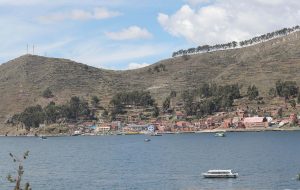
By Gina Baldivieso
Santiago de Ojje, Bolivia, Nov 3 (EFE).– The underwater archaeological ruins in Lake Titicaca, shared by Bolivia and Peru, are riches that Bolivian authorities are eager to add to the attractions of what is already one of the country’s main tourist destinations.
Titicaca is the highest navigable lake in the world at an altitude of 3,000 meters (l0,000 feet), covers over 8,500 sq. km (3,300 sq. miles), and serves a natural border between Bolivia and Peru.
Breathtaking landscapes with a blue sky blending with blue water, gastronomy, fishing and religious tourism are some of the attractions that bring local and foreign visitors to the Bolivian lakeside communities.
Added to these attractions will be, in the words of Bolivian Cultures and Tourism Minister Wilma Alanoca, a “visionary project” which will be the first underwater museum to show the Tiwanaku and Inca buildings discovered submerged in Lake Titicaca.
“It’s a very ambitious project that basically recovers our historic memory of how our ancestors occupied the entire lake region here on the altiplano,” Alanoca said.
It all began a decade ago when researcher Christophe Delaere of the Free University of Belgium carried out underwater explorations of the lake and detected several submerged archaeological sites, the head of the Archaeological Unit of Bolivia’s Cultures and Tourism Ministry, Jose Luis Paz, told EFE.
Later an agreement was signed with Belgium and the Lake Project was created to identify and preserve the subaquatic and lakeside archaeological heritage of Titicaca, in coordination with 13 municipalities in the La Paz region, where the lake is located.
Excavations were carried out with special compressors “and we confirmed that there are 25 subaquatic sites in the lake on the Bolivian side.” he said.
Picked for the installation of the museum among the 24 sites was the one at Ojjelaya, some five minutes from the town of Tiquina and 108 km (67 miles) from La Paz.
The remains found in Ojjelaya are from the Tiwanaku civilization that dates back to the period between 400 and 1100 AD and are mainly domestic structures and stone foundations.
Also found on the site in 2017 were some 10,000 archaeological remains, from bone carvings to cooking utensils.
“The first stage” of the project will be to finish the museum at Ojjelaya, and “from there spread out” the work to the other 23 sites, Paz said.
The project is in the final design stage which is planned to be finished in the first quarter of 2019, when the financing is expected to be assured and construction begins, at a cost of approximately $10 million.
